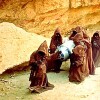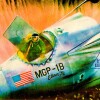From Bierstadt to Bob Ross: How Landscape Painting Re-Imagined the American West

Before the golden age of Hollywood Westerns, the mythology and allure of the American West was portrayed by dedicated, skilled landscape painters from Albert Bierstadt (1830-1902) to Frederic Remington (1861-1909) whose practices have captured cultural imaginations for over 150 years, and whose oeuvres have become synonymous with the history and vision of the archetypal 19th-century Old West.
Before that time, most of what was known back East about the far side of the Continental Divide came from the missives of early settlers and explorers like Lewis & Clark, who wrote about their 1804-06 excursion in extensive reports to President Thomas Jefferson who had commissioned the expedition to explore and map the newly acquired territory. This journal passage from an 1805 June day in Montana makes it easy to see why their coverage inspired a rush:
“Hearing a tremendous roaring above me I continued my route across the point of a hill a few hundred yards further and was again presented by one of the most beautiful objects in nature, a cascade of about fifty feet perpendicular stretching at right angles across the river from side to side to the distance of at least a quarter of a mile. Here the river pitches over a shelving rock, with an edge as regular and as straight as if formed by art, but without a niche or break in it; the water descends in one even and uninterrupted sheet to the bottom where dashing against the rocky bottom rises into foaming billows of great height and rapidly glides away, hissing flashing and sparkling as it departs the spray rises from one extremity to the other to 50 feet."
Of course, along with extensive written descriptions, there were renderings of the landscape, the wildlife and the residents of the land the newcomers encountered. But for the most part, these were essentially documentary in nature, rather than expressive or literary and lyrical. The works most people encountered from this time tended to resemble European academic standards of likeness and realism and depicted monumental landmarks like waterfalls, river bends, mountain ranges and sweeping plains in a way that was geared toward description and reportage. Classic American Western landscape painting as it came to be recognized had not yet matured into the full-blown genre of wildness, majesty and romance. That would come in the late 19th century when westward expansion increased. By then, along with the arrival of more settlers and railroads, the propaganda that compelled these newcomers increased and towns sprang up alongside the Westward migration that ensued.


All of this was tied up in the volatile situations and cultural agendas with regard to the First Nation peoples and the follow-on effects of the Civil War. The proto-cinematic allure of the Wild West as both a place and an idea was fully championed starting in the mid-late 19th century, and soon enough populated with a cast of archetypal characters (cowboys, outlaws, industrial pioneers, farmers and Native Americans) that would soon codify into the enduring iconography we still know today. This came along with a stylistic revolution as well, as the palette and surreal contours of the desert especially inspired a new generation of artists with the uniqueness of its light, palette and geology — which had no analog in the Indo-European tradition, and required a new language of line and color.
The unique personality of the West as expressed in its pantheon of creative acolytes continues to endure today, as evidenced in the contemporary rage for plein air painting, especially of the expansive Western lands. As late as the end of the 20th century, even beloved painting instructor Bob Ross(1942-1995) — he of the happy trees whose program “The Joy of Painting” ran from 1983-94 on PBS and is still going stronger than ever today onYouTube — even Bob Ross remained enchanted by its mythology.

Pasadena Museum of California Art (PMCA) is a non-collecting institution, but its long-standing relationships with associations such the California Art Club is still being celebrated in its modern-day curatorial ethos, as demonstrated in landmark historical survey exhibitions like 2016’s “In the Land of Sunshine: Imaging the California Coast Culture,” which featured paintings inspired by the views and lifestyles along the full 850-mile California coastline made from the mid-1800s to the present; along with 2012’s “Edgar Payne: The Scenic Journey,” which was the first major showing in 40 years for Payne (1883-1947), called by the curators “One of the most gifted of the historic California plein air artists.”
The Palm Springs Art Museum likewise has enjoyed a foundational relationship with regional artists and traditions, especially the Western landscape and the arts of its indigenous people and early settlers. Its permanent collection is one of the finest of its kind built on the twin pillars of Native American and Art of the West, curated in two sections: Desert Landscape and Western American. When founded in 1938, the mission of the Palm Springs Desert Museum (as it was known) was focused on natural sciences of the desert area but also included regional Native American culture. Along with the evocative, atmospheric realism of classical Western landscape painting in the high desert regions, there’s a markedly spiritualist, ruggedly transcendentalist strain, especially in relationship to the post-war and mid-century abstraction movements. A star in that firmament is the painter Agnes Pelton (1881-1961), a modernist painter who studied in New York and Europe, before, like so many, falling in love with the Coachella Valley and settling in Cathedral City, where she lived, painted and inspired others from 1932 until her death.

Perhaps no single institution is more associated with this rich legacy in American Art History than the Autry Museum of the American West. “Historical landscape art of the post-Civil War era has long been a cornerstone of the Autry Museum’s collection,” Amy Scott, the Autry’s Chief Curator says of the museum’s mission. Its collection starts with Gene and Jackie Autry’s purchase of Thomas Moran's 1875 masterpiece, “Mountain of the Holy Cross,” before the museum opened. The Autry’s landscape collections have been augmented since 2005 by a collections-sharing arrangement with the California Historical Society, which has brought major works by Albert Bierstadt, William Keith, William Coulter and more to the Autry. The museum built on this foundation with a number of contemporary landscape paintings of the Midwest, California, Colorado, Zion and other places important to the West today, including the Southwest and Navajo country.
The Autry has also done several shows that focus on or incorporate landscape over the years. Most notably, according to Scott, have been “Drawn to Yellowstone” (2004) and “Yosemite: Art of an American Icon,” which looked at the role of painting in shaping the National Park idea from its inception to the present. Currently, their Griffith Park location hosts Art of the West,” an ongoing exhibition which is the first of its kind to explore how shared values and interests have inspired artists from different cultures and times to create what Scott calls, “distinctive, powerful works that speak to their experience of the West as both a destination and a home.” Organized around three primary themes — Religion and Ritual, Land and Landscape, and Migration and Movement — “Art of the West” displays historical works by masters like Thomas Moran and Frederic Remington alongside more contemporary pieces by Georgia O’Keeffe, Virgil Ortiz, Luis Tapia, David Levinthal and many others. Shown with these icons are rarely seen artworks from the Autry’s collections, including the Southwest Museum of the American Indian Collection.

To that point, next year sees the Autry opening the much-anticipated exhibition “Indian Country: The Art of David Bradley” (March 30, 2019-January 5, 2020). For the past three decades, David Bradley (who is Minnesota Chippewa) has been a recognized voice from Indian Country, who, says Scott, “confronts through his art questions of identity, self-determination and self-representation, as well as definitions of “traditional” Indian art. Drawing influence from diverse sources such as Santa Fe-style painting of the 1930s-40s, Renaissance art, pop culture, advertising and film, Bradley’s work is at once serious and fun, historical and contemporary.”
“Our most significant painting is definitely Moran's‘Mountain of the Holy Cross,’” says Scott, “but examples byAlbert Bierstadt andAlfred Jacob Miller are also classics, and we are in the process of acquiring James Doolin's “Bridges,” a monumental painting that depicts where the 5 and 110 freeways meet. The Doolin, in particular, reminds me of Bierstadt's“On the Merced River” [a CA Historical Society property]. Both rely on similar compositions, both are California, both are iconic.” Another personal favorite of Scott’s is Emmi Whitehorse's refreshing and rather surreal“Canyon Lake III,” as it’s such a “completely different take on landscape and what it means, with a Zen-like translucency.”

Of course, not all landscapes are rural, pastoral, or even natural. For those who like their landscape painting a little more on the urban tip a la Doolin, this year’s edition of the annual Downtown Plein Air Festival, which just ran April 4-8, 2018 with an exhibition and awards event keyed to the April 12th DTLA Art Walk. One of its founders and among the more forward-looking of the contemporary plein air world is Alex Schaefer (of the Ross-inspired “Paint with Alex” and also “Burning Banks” series fame). He and his peers champion the urban plein air community — an old-is-new revival informed by the neighborhood’s atmospheric quirks and augmented by the clashing styles of its remarkable architecture and unusually (for L.A.) vibrant street scenes.






